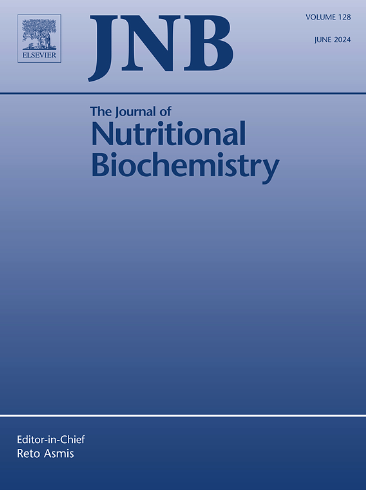HFD feeding for seven months abolishes STING disruption-driven but not female sex-based protection against hepatic steatosis and inflammation in mice
IF 4.8
2区 医学
Q1 BIOCHEMISTRY & MOLECULAR BIOLOGY
引用次数: 0
Abstract
Stimulator of interferon genes (STING) is positively correlated with the degrees of liver inflammation in human metabolic dysfunction-associated steatotic liver disease (MASLD). In addition, STING disruption alleviates MASLD in mice fed a high-fat diet (HFD) for 3 months (3-m-HFD). Here we investigated the role of the duration of dietary feeding in regulating MASLD in mice and explored the involvement of STING in sex differences in MASLD. Both male and female STING-disrupted (STINGgt) and wild-type C57BL/6J mice were fed an HFD for 3 or 7 months (7-m-HFD). Additionally, female STINGgt mice upon ovariectomy (OVX) and 3-m-HFD were analyzed for MASLD. Upon 3-m-HFD, STINGgt mice exhibited decreased severity of MASLD compared to control. However, upon 7-m-HFD, STINGgt mice were comparable with wild-type mice in body weight, fat mass, and MASLD. Regarding regulating the liver RNA transcriptome, 7-m-HFD increased the expression of genes indicating proinflammatory activation of various liver cells. Interestingly, the severity of MASLD in female mice was much lighter than in male mice, regardless of STING disruption. Upon OVX, female STINGgt mice showed significantly increased severity of MASLD relative to sham control but were comparable with male STINGgt mice. Upon treatment with 17-beta estradiol (E2), hepatocytes revealed decreased fat deposition while macrophages displayed decreases in lipopolysaccharide-induced phosphorylation of Nfkb p65 and Jnk p46 independent of STING. These results suggest that 7-m-HFD, without altering female sex-based protection, abolishes STING disruption-driven protection of MASLD, likely through causing proinflammatory activation of multiple types of liver cells to offset the effect of STING disruption.
喂食高纤维日粮 7 个月后,STING 干扰驱动的小鼠肝脏脂肪变性和炎症保护作用消失了,而雌性小鼠的保护作用却没有消失:喂食高纤维日粮改变了小鼠肝脏脂肪变性和炎症保护作用。
干扰素基因刺激器(STING)与人类代谢功能障碍相关性脂肪性肝病(MASLD)的肝脏炎症程度呈正相关。此外,STING 干扰能缓解喂食高脂饮食(HFD)3 个月(3-m-HFD)的小鼠的 MASLD。在此,我们研究了饮食喂养持续时间在调节小鼠MASLD中的作用,并探讨了STING在MASLD性别差异中的参与作用。雄性和雌性 STING 干扰(STINGgt)小鼠和野生型 C57BL/6J 小鼠均被喂食高纤维食物 3 个月或 7 个月(7-m-HFD)。此外,还对卵巢切除(OVX)和3-m-HFD的雌性STINGgt小鼠进行了MASLD分析。与对照组相比,STINGgt小鼠在接受3-m-HFD治疗后,MASLD的严重程度有所下降。然而,在7-m-HFD条件下,STINGgt小鼠的体重、脂肪量和MASLD与野生型小鼠相当。在调节肝脏 RNA 转录组方面,7-m-HFD 增加了表明各种肝细胞促炎激活的基因的表达。有趣的是,无论 STING 是否中断,雌性小鼠 MASLD 的严重程度都比雄性小鼠轻得多。与假对照组相比,雌性 STINGgt 小鼠在卵巢切除后,MASLD 的严重程度显著增加,但与雄性 STINGgt 小鼠相当。用 17-beta 雌二醇(E2)治疗后,肝细胞显示脂肪沉积减少,而巨噬细胞显示脂多糖诱导的 Nfkb p65 和 Jnk p46 磷酸化减少,与 STING 无关。这些结果表明,7-m-HFD 在不改变基于女性性别的保护作用的情况下,取消了 STING 干扰驱动的 MASLD 保护作用,这可能是通过引起多种类型肝细胞的促炎激活来抵消 STING 干扰的作用。
本文章由计算机程序翻译,如有差异,请以英文原文为准。
求助全文
约1分钟内获得全文
求助全文
来源期刊

Journal of Nutritional Biochemistry
医学-生化与分子生物学
CiteScore
9.50
自引率
3.60%
发文量
237
审稿时长
68 days
期刊介绍:
Devoted to advancements in nutritional sciences, The Journal of Nutritional Biochemistry presents experimental nutrition research as it relates to: biochemistry, molecular biology, toxicology, or physiology.
Rigorous reviews by an international editorial board of distinguished scientists ensure publication of the most current and key research being conducted in nutrition at the cellular, animal and human level. In addition to its monthly features of critical reviews and research articles, The Journal of Nutritional Biochemistry also periodically publishes emerging issues, experimental methods, and other types of articles.
 求助内容:
求助内容: 应助结果提醒方式:
应助结果提醒方式:


